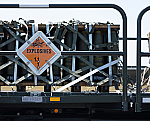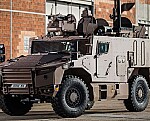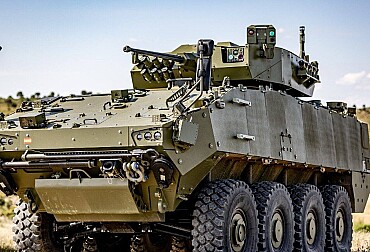Hell on wheels and tracks – Russian Multiple Launch Rocket Systems
In addition to gun-based artillery, Russia deploys a vast array of multiple rocket launchers, which can be classified into three categories according to the rockets carried: 300mm, 220mm and 122mm launchers.
The vehicles used are almost exclusively of ex-Soviet origin and therefore showing their age. Russia has launched a catch-up programme aimed at rapidly modernising its MRL fleet, as the latter systems are capable of generating a large volume of fire, but are cruelly lacking in precision, and encounter problems with mobility. In addition to the three main models inherited from the Soviet era which are the Smerch, the Uragan and the Grad, Russia has launched a modernisation programme based on a modern standardised platform using existing and proven mechanical components from the systems it is supposed to replace: the Tornado.
300mm: 9K58 Smerch and 9K515 Tornado-S
In the 300mm heavy rocket category, we find the 9K58 Smerch launcher which entered service in 1987. It is mounted on a MAZ-79111 wheeled chassis 8×8 or on a MAZ-543M and carrying 12 rockets capable of hitting targets in range of up to 90km. The Smerch fleet (around a hundred units in the land forces; two were documented to be lost in Ukraine) was strengthened with the arrival of the 9K515 Tornado-S. These are in fact Smerchs mounted on MAZ-543M chassis carrying 12 x 300mm tubes and featuring a new automated fire control system, a navigation system based on the GLONASS system, the ability to carry new ammunition and a reduced (re)deployment time designed to limit the risks of falling victim to counter-battery fire. The most reliable estimates indicate that Russia would have around 50 Tornado-Ss in service, with the aim to upgrade the Smerch systems to the Tornado-S standard, with the main work consisting of replacing the firing system and adding the GLONASS system.
220mm: 9K57 Uragan and 9K512 Uragan-M
The intermediate class of 220mm LRMs includes the 9K57 Uragan, which entered service in 1975 and is mounted on a ZIL-135LM 8×8 wheeled chassis. It has 16 tubes capable of hitting targets up to 35 km away. Russia has around 200 units in service, plus 400 vehicles in reserve (with 91 listed as destroyed or captured in Ukraine). The Uragan system was due to disappear in the medium term, mainly due to the obsolescence of its chassis and the system's lack of precision – the „special military operation“ however changed those plans. It is still theoretically due to be partly replaced by a modernised variant, the 9K512 Uragan-M, wich is however acquired in small quantities. This system, built on an MZKT-7930 wheeled chassis (8 × 8), has the particularity of being able to carry two types of tube: either 30 x 220 mm tubes, or 12 x 300 mm tubes.
122mm: 9K51 Grad and 9K51M Tornado-G
With a 122 mm rocket, it is the smallest model deployed by the Russian Army, although the system using it is one of the most famous: the 9K51 Grad. This MRL, development of which began in 1959, was accepted into service in 1963 and over 8,500 were produced between 1963 and 1988. Available in several variants, this system can be mounted on a Ural or Kamaz 6×6 wheeled chassis and can fire 40 rockets in a few seconds at a maximum range of 40 km, depending on the ammunition used and on the latest versions of the vehicle only.
The large number of rockets on board actually compensates for their lack of accuracy. Although there are still around 500 units in service in the Russian land forces (and more than 2,000 in reserve; with about 300 already lost in Ukraine), the Grad is nearing the end of its career, being replaced by the 9K51M Tornado-G. As its name suggests, the 9K51M Tornado-G is a modernised variant of the 9K51 Grad built on a Ural-4320 wheeled chassis 6×6 with 40 122mm tubes identical to those of the Grad, but capable of carrying a wider range of rockets.
The main improvements consisted of replacing the fire control system and installing satellite navigation systems. Russia has even launched work to modernise the most recent Grads by upgrading them to the Tornado-G standard, which will enable it to renew its 122mm rocket launcher capacity more quickly. Lastly, it is also looking into the possibility of mounting the Tornado-G system on a Kamaz-63501 8x8 wheeled chassis, which would increase its strike capability by deploying 40 122mm tubes that could be rapidly reloaded by carrying the necessary rockets directly on board; a solution that would save a great deal of time and reduce the system's logistical footprint with no need for reloading vehicles. No less than 20 Tornado-G are listed among Russian losses in Ukraine.
Thermobaric rockets: TOS-1A Solntsepyok
There remains the specific case of the TOS-1A system, also known as Solntsepyok, which is a MLRS with 24 x 220 mm tubes mounted on a T-72 tank tracked chassis. Its special feature is that it uses thermobaric rockets capable of hitting at a maximum distance of 6 km, in particular to destroy armoured or buried targets and buildings. The use of the T-72 chassis is based on one of the system's weaknesses: the short striking distance of the rockets, which requires greater protection for the crew. Given its specific nature and use of thermobaric rockets and unlike other Russian MLRS, the TOS-1A is not used by Russian line ground forces, but by „NBC protection troops“. The information available about this system varies, but it would appear that around a hundred TOS-1As are in service with about 30 listed as lost in Ukraine. Russia is also working on a wheeled version, to be known as the TOS-2 Tosochka, based on the Tornado-U 6×6 truck chassis.
All in all, according to Oryx, during the war in Ukraine, Russian army has lost 449 of its Multiple Launch Rocket Systems so far, of which were 353 destroyed, 40 damaged, 2 abandoned, and 54 captured. Generally the MLRS contitute a very important part of the Russian artillery fire power.









